
Aquí os traigo otro cuento revisado por Angela Carter, aunque esta vez no ha tenido que cambiar muchos detalles respecto a la historia original. Se trata de un cuento cuyo título le da nombre a toda la colección de cuentos de Carter, La cámara sangrienta, y habla sobre uno de los relatos más violentos y sangrientos que Charles Perrault pudo haber versionado nunca. Se trata de Barbazul. Ya hablé de ello en el audioblog dedicado a los cuentos de hadas, y es que muchos cuentos tradicionales que conocemos no son ni por asomo los originales, solo son versiones de versiones, de versiones... Pero en el caso que nos ocupa, se sabe que la historia de este hombre rico y asesino de mujeres tiene su origen en un cuento popular francés llamado La barbe bleu (La barba azul). Como la mayoría de cuentos populares, en este también hay una gran distinción en lo que se refiere a roles de género; hay mucho interés en la virginidad de la mujer, pero lo que lo hace ligeramente distinto a los demás son dos factores: en primer lugar, el protagonista masculino es un asesino en serie, y en segundo lugar, este personaje está basado en un noble llamado Gilles de Rais.

Este "buen" hombre se dedicaba a matar y torturar niños por placer
Este último detalle creo que es fundamental, porque lo tenebroso de este cuento no tiene que ver solo con el horror explícito de violencia y muerte, sino que está basado en una persona que realmente existió y cometió esas atrocidades. Esto quiere decir que los cuentos de hadas a veces parece que solo son simples metáforas sin base real. Por supuesto, nadie va a creer que los lobos hablen, ni que los hombres se puedan transformar en bestias horripilantes. Pues por estas razones, el personaje de Barbazul es mucho más intenso que todo lo antes visto; su proximidad a la realidad lo hace terrorífico y atrayente a la vez. No es extraño entonces que la crítica feminista pueda encontrar cierto placer analizando su argumento: un hombre poderoso se casa con un gran número de mujeres a las que tortura y asesina para satisfacer su sadismo y sus ansias de poder sobre ellas. Es violencia de género representada en un cuento cuyos elementos centrales son muy básicos: una joven y hermosa mujer, un hombre mayor que ha enviudado varias veces, y la figura (masculina) que rescata a la mujer.
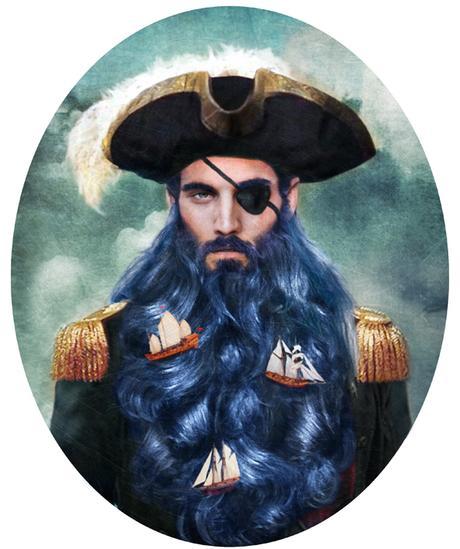
Atención aparte merece esa espesa y frondosa barba, pues es símbolo de masculinidad y heterosexualidad
Obviamente, lo primero que nos viene a la cabeza al pensar en Barbazul, es en el tema del maltrato hacia mujeres, pero la visión de Angela Carter va un poco más allá, pues la conexión que ella establece es entre el imperialismo y la violencia doméstica. El Barbazul del que ella habla es un aristócrata muy rico que se encuentra protegido por un sistema político-cultural que le permite transgredir cualquier límite que le venga en gana. De hecho, toda su riqueza precede al colonialismo. Por el contrario, la protagonista femenina no es solo la más joven de sus mujeres, sino que también es la más inocente y vulnerable, pues no puede evitar el instinto de saber qué es lo que pasa a su alrededor. Su comportamiento recuerda mucho a la Eva de la Biblia, o a la figura mitológica de Pandora. Ambas mujeres querían acceder al conocimiento, acto por el cual fueron duramente castigadas al final. De esta manera es cómo la figura dominante, ya sea Barbazul o Dios mismo, puede sentirse libre de justificar su violencia hacia los demás. De hecho, la referencia a Pandora no es casual, pues uno de los libros que la joven mujer encuentra en la librería de Barbazul se titula El secreto de la caja de Pandora.
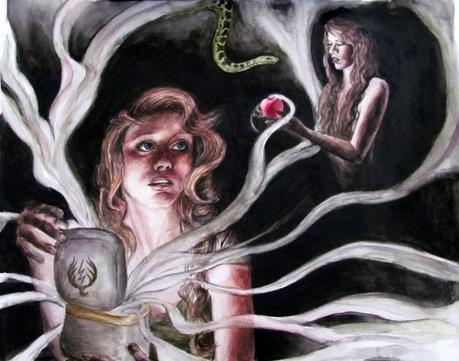
Y por culpa de mujeres curiosas, la humanidad está como está; culpémoslas por todo
El simbolismo sexual es algo que también está muy presente. La llave ensangrentada es ni más ni menos que la transgresión sexual femenina, y eso es lo que desata la ira de su marido, pues en este caso la desobediencia es prácticamente adulterio. Además de esto, la llave parece tener poder sobrenaturales cuando la joven descubre que puede ver la sangre de la mujer anterior a ella, y aunque intenta eliminar esa sangre de la llave por todos los medios, nunca desaparece. Así, la llave se convierte en una herramienta cuyo propósito principal es hacer que la mujer sea consciente de su propia opresión. Aún queda mucho más por contar sobre sexualidad, y sobre quién desempeña en esta historia el papel del héroe, pero eso será en la próxima entrada. Todos los comentarios son bienvenidos.
Fuente de las imágenes:
https://es.pinterest.com/pin/576249714801223061/
https://albherto.wordpress.com/2011/06/18/asesinos/
http://www.taringa.net/posts/info/18214625/Gilles-de-Rais-La-verdadera-historia-de-Barba-Azul.html
https://allaroundarts.wordpress.com/2012/11/30/watercolor-and-ink-art-mediums-part-3/pandora-eve/-----------
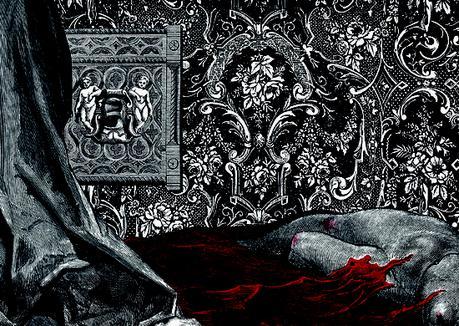
Here you have another revised tale by Angela Carter, although not many details have changed with regard to the original story. It's about a tale whose title is the title of the whole collection of tales written by Carter, The bloody chamber, and its plot is one of the most violent and bloody stories that Charles Perrault have versioned ever. It's Bluebeard. I talked about that on the audioblog about fairy tales, because the truth is that many classic fairy tales we know are not like the original ones; they are versions, of another versions, of another versions... But in this case, it's well known that the story of this killer of women has its origin in a french folktale called La barbe bleue (The blue beard). As most folktales, we can find here a great distinction of gender roles: there's a big interest in the woman's virginity, but what makes it different from the others are two factors: firstly, the male protagonist is a serial killer; secondly, this character is based on the nobleman killer Gilles de Rais.

This "nice" man killed and tortured children for pleasure
This last detail is essential, because the gloomy thing about this tale has to do not just with the explicit horror of violence and death, but it has its basis on a man who actually existed and he commited all those atrocities. That means that sometimes fairy tales seem to be simple metaphores which have nothing to do with reality. Of course, no one believes that wolves speak, nor men can be transformed into horrible beasts. That's why Bluebeard is more intense than the foregoing, because its proximity to reality makes this story something appealing and frightening at the same time. So it's not strange that feminist criticism finds some kind of pleasure analyzing its plot: a powerful man marries a wide range of woman who are tortured and murdered by him in order to satisfy his sadism and to build his power over them. It's domestic violence portrayed in a tale, whose central elements are very basic: a young and beautiful woman, an old man who has widowed several times, and the (male) figure who rescues the woman.
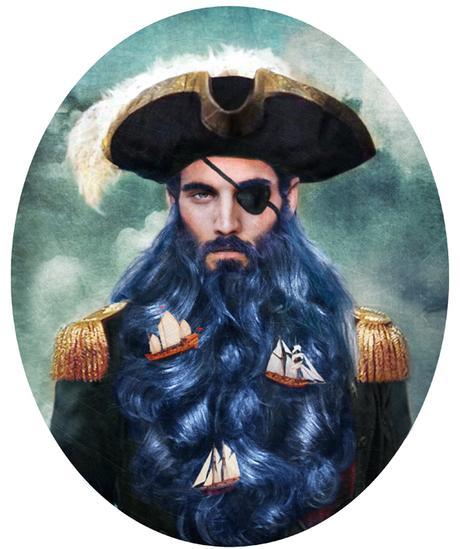
Special attention should be paid to that thick and bushy beard, because it symbolizes masculinity and heterosexuality
It's obvious that the first thing coming to our mind when we think about Bluebeard is violence against women. But Angela Carter gives us a vision that goes beyond that because she stablishes a link between imperialism and domestic violence. The Bluebeard she describes is a wealthy aristocrat which is protected by a political-cultural system that allows him to infringe all the limits he wants. In fact, his wealth precedes the colonialism situation. On the contrary, the female protagonist is not only the youngest among his wives, but also the most vulnerable and innocent, and she can't avoid her instincts of wanting to know what happens around her. Her behaviour is quite similar to Eve from the Bible, or the mythological figure of Pandora. Both women wanted to get access to knowledge, only to be punished at the end. In this way is how the dominant figure, either Bluebeard or God, could feel free to justify his own violence against others. In fact, the reference to Pandora is not a casualty, because one of the books that the young woman finds in Bluebeard's library is called The secret of Pandora's box.
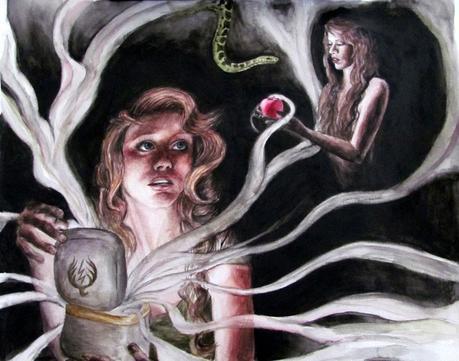
Because of curious women, humanity is in such state; let's blame them for everything
Sexual symbolism is remarkable too. The bloody key represents female sexual trangression, something that produces rage within her husband emotional state because, in this case, disobedience is adultery. Moreover, this key has some kind of supernatural powers when the woman sees the blood of the previous wives on it, and although she tries to clean the blood, it never disappears. This is how the key is used as a tool whose main purpose is make the woman aware of her own oppression. There's still much more to tell about sexuality and about who has the role of the hero in this story, but we will se that in the next entry. All comments are welcome.
Images source:
https://es.pinterest.com/pin/576249714801223061/
https://albherto.wordpress.com/2011/06/18/asesinos/
http://www.taringa.net/posts/info/18214625/Gilles-de-Rais-La-verdadera-historia-de-Barba-Azul.html
https://allaroundarts.wordpress.com/2012/11/30/watercolor-and-ink-art-mediums-part-3/pandora-eve/-------------------

